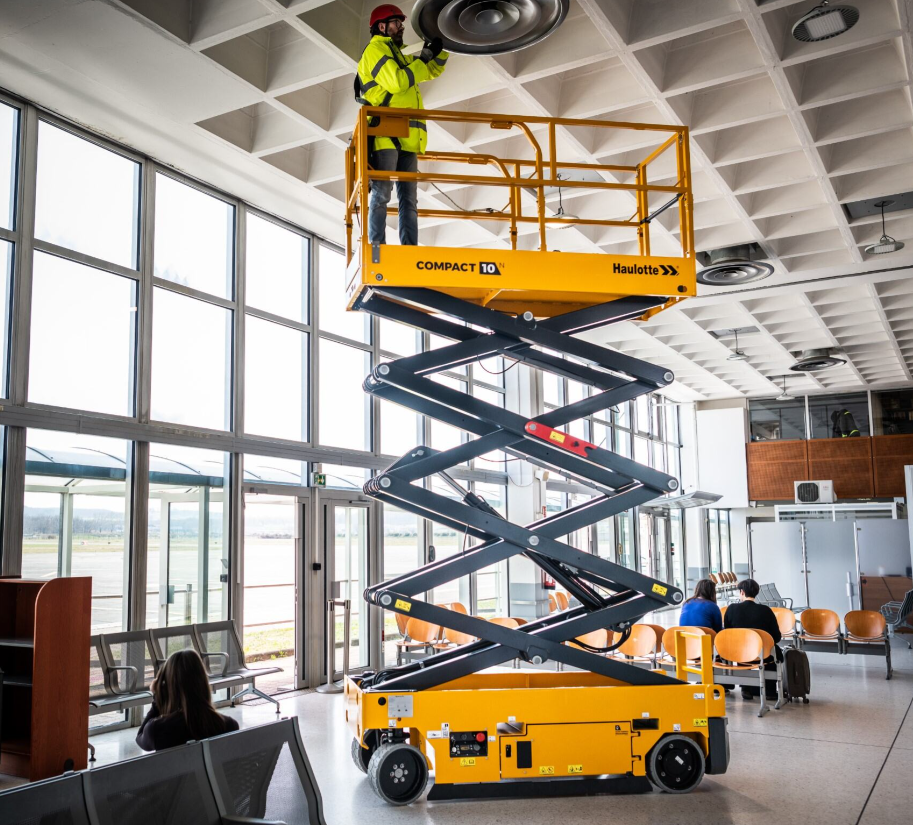How To Choose the Right Scissor Lift for Your Jobsite
Trade Advice
4 Essential tips
There are so many models of scissor lift to choose from, each designed with specific jobs in mind. Our partners Haulotte offer a great range via Kennards Hire , and to ensure you get exactly the right tool for the job at hand, they’ve put together this handy check list.
1. Assess the specific needs of your jobsite
The first thing to consider is the nature of the task at hand. Before selecting a scissor lift, ask yourself the right questions: How high do you need to work? Will you need to lift multiple people or materials? Is the working space restricted? These questions will help determine the lift capacity and working height you need. It is also important to consider the type of terrain (indoor or outdoor) to choose between an electric or a diesel-powered scissor lift.
For indoor tasks, an electric scissor lift is ideal, as it produces no emissions and operates quietly. On the other hand, for outdoor job sites with rough or uneven terrain, a rough terrain scissor lift will be more appropriate, with diesel, electric or hybrid engine. Make sure that the selected model has the necessary tyres and stability to ensure optimal safety.
For specific types of work, it’s worth taking an in-depth look at the options available on the different models of machine. Some options will help you save time and be more efficient on site. For example, for insulation and cladding work, ability to drive at full height with a full load is an essential option. Full-height drive allows the scissor lift to move along the wall at full height, with full load capacity, reducing the number of round trips between the ground and the work area.
2. Check the load capacity and maximum working height
A scissor lift must not only reach the required height but also support the load you plan to lift. Load capacity depends on the model. For indoor work, compact and lightweight lifts are preferable, while for large outdoor sites, heavier lifts with greater working height are necessary.
Scissor lifts come with various platform capacities, which vary depending on the model and purpose. In general, most lifts can support between 230 kg and 500 kg, including both operators and equipment. Models used for heavy-duty work, like installing large signs or handling bulky materials, offer a higher capacity. However, the load capacity decreases when using platform extensions, so operators should always consider this when planning a project. It’s essential to balance the load evenly and never exceed the manufacturer’s Safe Working Load (SWL) to avoid operational issues.
3. Evaluate mobility and compactness
If your job site requires frequent movement or if you work in confined spaces, the compactness and manoeuvrability of the scissor lift are key factors to consider. Lifts with precise steering systems and compact platforms allow easy access to hard-to-reach areas. Additionally, some scissor lifts are designed to pass through standard doors or to work in narrow corridors.
For narrow spaces, especially indoors, it’s extremely important to check beforehand, with a site visit, all the openings through which you will be passing the machine, as well as the area where the machine will be moving. Walking the route the machine will take is a good way of getting an idea of the space available.
Some scissors have options to improve manoeuvrability and help you get through tricky passages. For example, the HS15 E and HS18 E models in the PULSEO Range, or the COMPACT Range from Haulotte, have fold-down guardrails to reduce the height of the machine.
4. Consider safety features and maintenance
Safety should always be a top priority on any job site. Before renting a scissor lift, check that it is equipped with the necessary safety features, such as guardrails, over-tilt alarms, and automatic stabilisation systems. Regular maintenance extends the life of the equipment and reduces the risk of accidents due to wear and tear. Ensure that you select a model known for its reliability and safety.
Choosing the ideal scissor lift for your job site involves a careful assessment of your specific needs, the working environment, access to grid for recharging batteries, and safety criteria. By considering factors such as height, load capacity, mobility, and maintenance, you will not only ensure efficient work but also guarantee the safety of your teams. Make sure to research thoroughly before making your choice to secure equipment that perfectly matches your project’s requirements.
Use this checklist to make sure you choose the right equipment:
- What is the type of the job (cladding, insulation, maintenance)?
- Will you be working indoors, outdoors or both?
- Are there any difficult-to-access areas, narrow spaces or congested areas on the site?
- Will you have access to the electricity network or a site meter to recharge the aerial platform batteries?
- What load will you need to carry on the platform (equipment, materials, number of operators)?
- Are you working in confined space and/or is primary guarding sufficient enough for the job?
- Do you require secondary guarding or overhead protection?
Advice is courtesy of Haulotte, one of the world’s leading manufacturers of access equipment.
If you need help clarifying anything, you can always give one of the Kennards team a call on 135 135, and we’ll be happy to help. We can even come along to your site to double check with you, so you can be absolutely sure which equipment will be right for your job.

